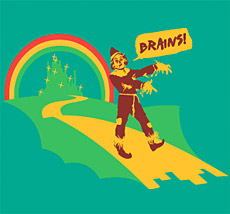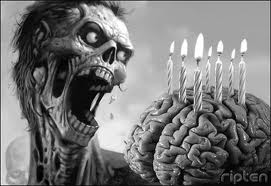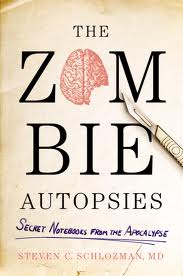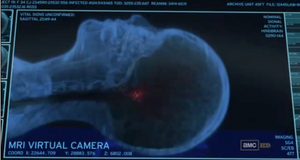Zombies, brains, and media, oh my!
Zombies attack! – well, the media, anyway. From movies and television shows (this past Sunday on Glee!) to books and conventions, zombies are taking over.  Last year, “Seattle, the self-proclaimed zombie capital of the world, was host to ZomBcon, the first ever Zombie Culture Convention, over Halloween weekend at the Seattle Center Exhibition Hall.
Last year, “Seattle, the self-proclaimed zombie capital of the world, was host to ZomBcon, the first ever Zombie Culture Convention, over Halloween weekend at the Seattle Center Exhibition Hall.
A “symbolic tribute” to zombie film director, George A. Romero, the event allowed fans to gather over three days to “celebrate all things zombie.” The creator, Ryan Reiter, also organized a Red, White & Dead Zombie Walk for Independence Day (Guinness Book World Record for “largest gathering of zombies” with 4200… New BU Initiative: Beat this Guinness Book World Record?)
Back to zombies though – on April 13th, 2009, Dr. Steven Schlozman , a Harvard psychiatrist, went to the Coolidge Corner Theater (close by in Brookline!) to discuss and answer questions about the neurobiology of zombies before a screening of Night of the Living Dead.
Having studied zombie films and literature as well as consulting with the director Romero noted above, Dr. Scholzman is quite informed in zombie-ology. Amazingly, the enthusiastic response from th e moviegoers inspired him to go viral and, according to Rebecca Jacobson on PBS, “take the lecture nationwide.”
e moviegoers inspired him to go viral and, according to Rebecca Jacobson on PBS, “take the lecture nationwide.”
Ira Flatow of National Public Radio had an interview with him in October 2009, in which of Dr. Scholzman, he says his fake research aids attempts to “see if there could be…a vaccine to protect us from … zombies, just in case.” Later, when asked by a caller about the different kinds of zombies portrayed in movies, he distinguished between the typical, slow Romero-type of zombie and the fast, more sophisticated “28 Days later” type that can exhibit hunting and other pack behaviors – “neurobiologically speaking, they got to be different.” 
He has actually also written a popular science book, The Zombie Autopsies: Secret Notebooks from the Apocalypse. With 208 pages of zombie-brain-apocalyptic fun, his book will be released March 25th, 2011 for as little as $11.25 on Amazon. (Check out his zombieautopsies twitter for more on the book and his theories!)
Rebecca Jacobson notes that Dr. Scholzman is using a very straightforward, fun, teaching approach to help his students apply neuroscience to new situations. Dr. Scholzman believes adults “learn better when they can apply new knowledge to something familiar, before going on to tackle more complex neuropsychiatric cases.”
Teaching science in new ways is very valuable to Doron Weber of the Sloan Foundation, which has “has promoted filmmakers writing screenplays and making movies with science themes.” He says, “science and technology are woven into the fabric of our lives, but people all too often see it as something exotic or unusual. What we are doing here is bringing the real person, a scientist, so people can see that science is a very human activity.”
The Coolidge Corner Theater tries to bring science to the public by holding Science on Screen events, tickets only $7.75 for students. This February 21st, the film Death in Venice will be screened following a discussion with Nancy Etcoff, who is a psychologist on the faculty at Harvard Medical School. She wrote Survival of the Prettiest: The Science of Beauty. Just a month later, on March 21st, Transcendent Man will be screened and discussed with both Ray Kurzweil, “one of the world’s leading futurists,” and director Barry Ptolemy. Go to http://www.coolidge.org/science for more information!
Back to brains though! In Dr. Scholzman’s fictional, futuristic papers on the neurobiology of zombies, he writes that zombies suffer from ANSDS (Ataxic Neurodegenerative Satiety Deficiency Syndrome). He strives to explain the hunger, rage, movement, and so forth of zombies. Interestingly, he says that zombies can only be fueled by rage, like crocodiles, and hence, have highly active amygdalae. Because of this, he originally named their syndrome RAH (Reptilian Aggression Hunger Syndrome), but that was before the fictional International  Classification of Disease decided to change it to ANSDS in “2012”… find out more, including his theory on how zombies always eat but never..you know excrete, here!
Classification of Disease decided to change it to ANSDS in “2012”… find out more, including his theory on how zombies always eat but never..you know excrete, here!
While Dr. Scholzman is not the only person to try to explain the neuroscience of zombies, he does it very well and has been received enthusiastically by many. Interestingly though, the new hit TV series, The  Walking Dead, attempts describing what happens to the brain after infection and into resurrection. Watch this Youtube clip to see Dr. Edwin Jenner use MRI virtual camera to show the other characters what he has learned of zombies! How does his explanation line up with Dr. Scholzman’s? What’s your theory?
Walking Dead, attempts describing what happens to the brain after infection and into resurrection. Watch this Youtube clip to see Dr. Edwin Jenner use MRI virtual camera to show the other characters what he has learned of zombies! How does his explanation line up with Dr. Scholzman’s? What’s your theory?
Sources:
A Head-Shrinker Studies The Zombie Brain – Ira Flatow, National Public Radio
ZomBcon 2010: Seattle Hosts First Ever Zombie Convention – Timothy Lemke, Yahoo! Games, Plugged in
A Harvard Psychiatrist Explains Zombie Neurobiology – Mark Strauss, io9 forum
What Zombies Can Teach Us About Brains – Rebecca Jacobson, PBS
Silver Screen Scientists Unleashed – Dan Vergano, USA Today
Reality Television's Pica Craze
It seems that TLC’s latest tactic to garner higher ratings is by the exploitation of those suffering from pica, a disease where people feel the compulsion to eat things that are not food.
See a video here: Kesha has an "addiction" to eating toilet paper!
“My Strange Addiction” features a number of people with obsessions ranging from odd to dangerous, and a good third of the participants this season are clearly, to anyone who has taken an Abnormal Psychology class, suffering from pica. So far this season, people consumed toilet paper, household cleanser, detergent and soap, couch cushions, and glass. On a recent episode a man even swallowed bullets.
Pica is a serious condition. It can lead to the abnormal ingestion of dangerous chemicals, nutritional deficiencies, blockages in the digestive tract, tears in the intestines, and infections.
One featured addict, Crystal, ingested the household cleaner Comet for 30 years. After an inevitable trip to the dentist, she was informed that the majority of her teeth had eroded-- even at the root. Crystal’s dentist said her condition was the equivalent to a “meth mouth.” Restoring her teeth took months of dental surgery totaling over $20,000.

Pica is typically a childhood occurrence usually lasting a few months, but those featured on this show are adults and they clearly need help. The producers of “My Strange Addiction” claim to help those featured on the show seek help. Every participant is encouraged to attend intensive therapy because behavioral counseling is the most widely used treatment for this incurable disease.
Staying in therapy after the filming of the show ends is not obligatory. At the end of Episode 3, Crystal’s chances of remaining in therapy seemed slim. Her disorder stems from her difficult childhood that started with sexual abuse. Her problem needs serious attention, and should not to be featured as some sort of novelty on a reality TV show.
If “My Strange Addiction’s” producers worked to ensure that the sufferers on the show committed themselves to a therapy plan, it might be acceptable to have a show of this nature. The way the program is currently set up, those involved with “My Strange Addiction’s” production are no longer simply innocent bystanders. There may be no law saying that when you see someone in trouble you are supposed to help them, but this is not a political issue; it’s a moral one. The creators of this program are morally obligated to help these ill individuals instead of solely using them to make money.
Works Cited:
My Strange Addiction Focuses on Unusual Obsessive Behavior - ABC News
Mental Health and Pica - WebMD
Dentist Helps Metro Detroit Woman Addicted to Comet Cleaner - Fox